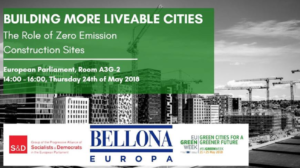On May 24th, there is a Conference in the European Parliament in Brussels about: ‘Building greener and more liveable cities: the role of zero emission construction sites’. This conference, approved as an official EU Green Week 2018 Partner event, takes a closer look at zero emission construction sites.
Electric mobility is increasingly recognised, among policy makers and industry alike, as the most promising measure to lowering climate-warming CO2 emissions and tackling hazardous air- and noise-pollution in urban areas. Electrification is rapidly becoming an accessible decarbonisation option also for the machinery used in the construction and renovation of the built environment.
While it is well known that construction sites are the source of different forms of pollution – including material waste, visible dust, noise, and vibration – construction and demolition sites also produce less obvious pollutants which are of serious concern for human health. The vast majority of this pollution comes from the thousands of diesel diggers, generators and other machines operating on construction sites.
Electrification
Europe can rid itself of vast amounts of urban pollution by targeting the electrification of construction machinery. A recent Bellona-sponsored study shows that construction sites emit more than 400 000 tonnes of CO₂ per year in Norway alone. This corresponds to the emissions from all passenger cars and lighter vehicles in Oslo, in addition to 5,1 tons of NOx.
In recognition of these vast, climate, environmental, and human health implications, Norway has placed ‘zero emission construction sites’ high on its agenda in recent months, and a number of public builders are already investing in and demanding emission-free construction sites. While 25% of emissions in Oslo are from construction machines, the city has a target of reducing emissions by 50% by 2020, and by 95% by 2030. Since 2017, the City Council has set a minimum requirement of fossil-free construction sites in public procurement procedures.
EU-regulations
The EU has already taken a first step to tackling these emissions. Regulation (EU) 2016/1628 aims to progressively reduce emissions from non-road mobile machinery and phase out equipment with the most polluting engines. Drawing on the Norwegian experience, decarbonising the EU construction sector, necessitates a common development course and dialogue between public authorities that are key to facilitating the right regulatory and financial framework, and market participants with hands-on expertise and the resources to deploy the solutions.
Source: Bellona.org

